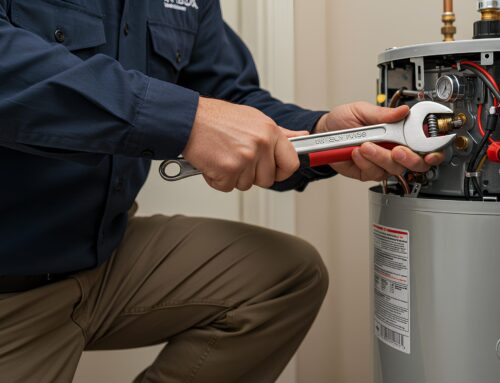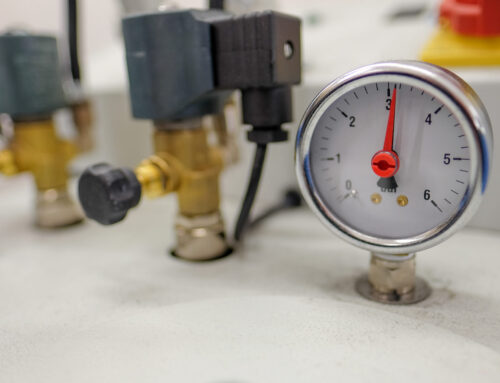Autumn in Connecticut brings stunning foliage … along with clogged gutters, blocked drains, and hidden plumbing headaches. As leaves fall and decompose, they can accumulate in your rooftop gutters and outdoor drains, eventually causing backups, overflows, or interior leaks.
At bluefrog Plumbing + Drain of Central CT, we’ve seen how neglected fall drain maintenance can lead to serious problems. Below are our expert tips to help you get ahead of trouble this season.
Why Autumn Maintenance Matters
- Water backup risk: When gutters and downspouts are clogged, rainwater (or melting snow) has nowhere to go except over the edges, which can saturate siding, erode foundation soil, or leak into basements.
- Ice formation danger: If leaves trap moisture, the next freeze spell can lead to ice dams, which can damage roofing and gutters.
- Root and debris buildup: Leaves, sticks, and organic detritus in drains breed mold, attract pests, and restrict water flow over time.
- Protect your plumbing system: Blockages in exterior drains often translate into stress on interior plumbing (floor drains, sump pumps, etc.).
With some preventive care now, you can avert expensive repairs down the line.
Fall Gutter & Drain Step-by-Step Maintenance
1. Clear the Gutters (Top & Bottom)
- Use a sturdy ladder and gloves and scoop out debris by hand or with a gutter scoop tool.
- Flush the gutters with a hose as you work to help remove remaining sediment.
- Don’t forget to clean the underside of any gutter guards or screens, since debris can still cling there.
2. Inspect & Clean Downspouts
- Run water through the downspout to test flow. If water backs up or overflows at the gutter, there’s likely a clog.
- Use a plumber’s snake or flexible rod to reach blockages. In tougher cases, a pressure nozzle or a professional hydrovac/hydro-jet tool may be needed.
- Ensure the downspout terminates at least several feet away from the foundation (use extensions or splash blocks if needed).
3. Add or Repair Gutter Guards & Screens
- Installing quality guards helps reduce how many leaves enter the gutter channel in the first place.
- Check existing guards for gaps or bends where debris can sneak through.
- Choose guards that are easy to remove/clean—this avoids frustration when maintenance is due.
4. Check Exterior Drains & Surface Grates
- Trees often drop leaves directly over drip pans, patio drains, or surface scuppers. Be sure to remove leaves and test that grates aren’t clogged.
- Lift and inspect catch basins or storm drains adjacent to your home; clean out accumulated leaf litter and ensure proper slope to carry water away.
5. Monitor Downhill Flow and Discharge Paths
- Walk the perimeter of your house during a rainstorm to see where water flows. If it’s pooling or backing toward the foundation, consider relandscaping or installing swales/trenches to reroute runoff.
- Keep gutter outflows unobstructed from shrubs, fencing, or mulch beds.
6. Schedule a Final Inspection Before Winter
- After your initial cleanup, give everything one more test just before the first freeze.
- Check for new blockages, shifting guards, or early ice formation.
- Consider hiring a pro plumber or drainage specialist for a camera inspection or pressure cleaning for any stubborn spots.
Connecticut-Specific Tips & Timing
- Best time window: Late October to early November—after most leaves have dropped, but before hard freezes—tends to be ideal in Connecticut.
- Watch for early leaf loss: Some maples and birches shed leaves earlier; keep an eye on them and clean sooner in affected zones.
- Frequent storm cycles: Fall in Connecticut often brings successive rainstorms. Cleaning early keeps you ready before the next downpour.
- Freeze-thaw caution: As temperatures fluctuate, wet leaves can freeze to surfaces and create blockages. Be extra vigilant in late fall.
When to Hire a Professional
- Stubborn clog removal: Some blockages are deep, compacted, or obstructed in the roof trough or downspout elbows and professional tools (e.g., hydro-jet, sewer rods, camera inspection) may be required.
- Prevent damage or injury: Ladder work and roof cleaning carry risk; trained plumbers have safety gear and techniques.
- Comprehensive assessment: Pros can spot subtle issues like misaligned gutters, sagging segments, or hidden leaks that homeowners might miss.
- Long-term investment: A single flooded basement or mold remediation job often costs far more than a preventive service.
If you’re located in Meriden, Wallingford, North Haven, Durham, Middletown, or surrounding Central CT towns, the bluefrog plumbing team is ready to help you with drain inspections, full exterior plumbing diagnostics, and more. Book your fall maintenance service before the snow flies.
Fall drain maintenance is one of the simplest yet most effective steps you can take to protect your home from water damage during wet and freezing seasons. By clearing debris early, using guards, and staying vigilant with inspections, you can help ensure that gutters and outdoor plumbing carry water safely away and out of your basement.
If you’d like help with drain or other inspections, or any plumbing support in Central Connecticut, bluefrog Plumbing + Drain is just a call away. Visit us at bluefrogplumbingcentralct.com to schedule your inspection or join our membership program! Stay ahead of the leaves and avoid costly surprises this winter.








